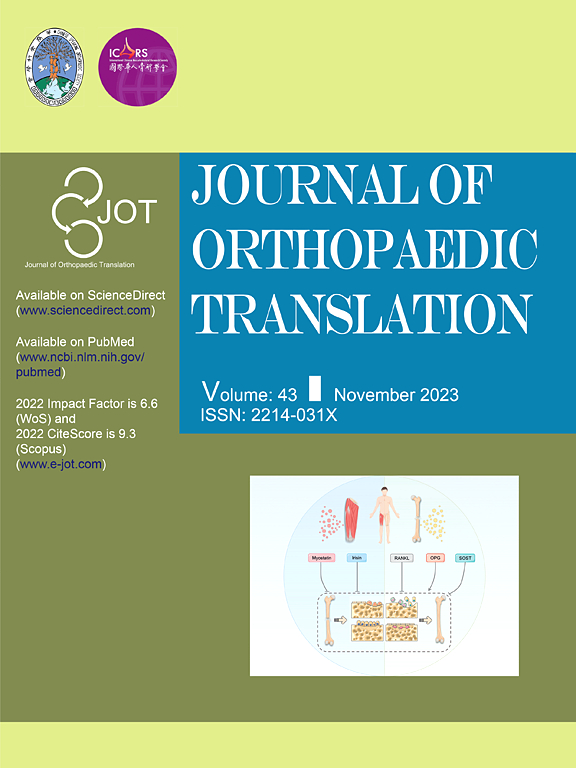LRP1 mitigates intervertebral disc degeneration by inhibiting endoplasmic reticulum stress through stabilizing the PPARγ
IF 5.9
1区 医学
Q1 ORTHOPEDICS
引用次数: 0
Abstract
Background
Intervertebral disc degeneration (IDD) is a significant cause of lower back pain, characterized by inflammation-mediated extracellular matrix (ECM) degradation, apoptosis, and aging of nucleus pulposus (NP) cells. Identifying key regulatory targets for these processes is crucial for IDD treatment. Previous research has highlighted the role of low-density lipoprotein receptor-related protein 1 (LRP1) in regulating ECM levels and cell fate, but its role in IDD remains under-explored. This study aims to elucidate the function and mechanism of LRP1 in the progression of IDD.
Methods
LRP1 expression was assessed in clinical tissue samples from patients diagnosed with IDD and in a rat IDD model established using needle puncture injuries. The effects of LRP1 knockdown and treatment with the LRP1 activator SP16 on apoptosis and ECM metabolism in NP cells were analyzed, with a focus on their relationship with endoplasmic reticulum (ER) stress. The interaction and regulatory mechanism between LRP1 and peroxisome proliferator-activated receptor gamma (PPARγ) were further explored to clarify how LRP1 regulates ER stress. Finally, the in vivo therapeutic effect of SP16 was investigated using a rat tail IDD model.
Results
We found that LRP1 expression was significantly downregulated in IDD. In NP cells with LRP1 knockdown, there was a marked increase in apoptosis and detrimental ECM remodeling, which were associated with the activation of ER stress. Our research further revealed that LRP1 interacts with PPARγ, stabilizing the PPARγ protein and preventing its lysosomal degradation, thereby mitigating ER stress. Activation of LRP1 in our models significantly reduced ER stress, matrix degradation, and apoptosis, thereby attenuating IDD both in vitro and in vivo.
Conclusion
This study systematically investigated the role and mechanisms of the LRP1/PPARγ/ER stress signaling axis in IDD. Our findings suggest that targeting LRP1 to modulate this signaling pathway could provide a promising therapeutic approach for the treatment of IDD.
The Translational potential of this Article
Our study demonstrated that LRP1 can reduce apoptosis and ECM degradation by inhibiting ER stress through stabilizing PPARγ, indicating that targeting LRP1 may be a novel therapeutic strategy for IDD.

LRP1通过稳定PPARγ抑制内质网应激减轻椎间盘退变。
背景:椎间盘退变(IDD)是下腰背痛的重要原因,其特征是炎症介导的细胞外基质(ECM)降解、细胞凋亡和髓核(NP)细胞老化。确定这些过程的关键调控目标对于治疗缺乏症至关重要。先前的研究强调了低密度脂蛋白受体相关蛋白1 (LRP1)在调节ECM水平和细胞命运中的作用,但其在IDD中的作用仍未得到充分探索。本研究旨在阐明LRP1在IDD发病过程中的作用及机制。方法:在诊断为IDD的患者临床组织样本和针刺损伤大鼠IDD模型中检测LRP1的表达。我们分析了LRP1基因敲低和LRP1激活剂SP16对NP细胞凋亡和ECM代谢的影响,并重点研究了它们与内质网(ER)应激的关系。进一步探讨LRP1与过氧化物酶体增殖物激活受体γ (PPARγ)的相互作用和调控机制,以阐明LRP1如何调节内质网应激。最后,采用大鼠尾巴IDD模型研究SP16的体内治疗作用。结果:我们发现LRP1在IDD中表达显著下调。在LRP1基因敲低的NP细胞中,凋亡和有害的ECM重塑明显增加,这与内质网应激的激活有关。我们的研究进一步揭示了LRP1与PPARγ相互作用,稳定PPARγ蛋白并阻止其溶酶体降解,从而减轻内质网应激。在我们的模型中,激活LRP1可显著降低内质网应激、基质降解和细胞凋亡,从而在体外和体内均可减轻IDD。结论:本研究系统探讨了LRP1/PPARγ/ER应激信号轴在IDD中的作用及其机制。我们的研究结果表明,靶向LRP1调节这一信号通路可能为治疗IDD提供一种有希望的治疗方法。本文的翻译潜力:我们的研究表明,LRP1可以通过稳定PPARγ抑制内质网应激,从而减少细胞凋亡和ECM降解,这表明靶向LRP1可能是治疗IDD的一种新的治疗策略。
本文章由计算机程序翻译,如有差异,请以英文原文为准。
求助全文
约1分钟内获得全文
求助全文
来源期刊

Journal of Orthopaedic Translation
Medicine-Orthopedics and Sports Medicine
CiteScore
11.80
自引率
13.60%
发文量
91
审稿时长
29 days
期刊介绍:
The Journal of Orthopaedic Translation (JOT) is the official peer-reviewed, open access journal of the Chinese Speaking Orthopaedic Society (CSOS) and the International Chinese Musculoskeletal Research Society (ICMRS). It is published quarterly, in January, April, July and October, by Elsevier.
 求助内容:
求助内容: 应助结果提醒方式:
应助结果提醒方式:


